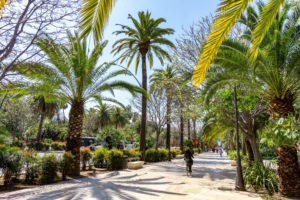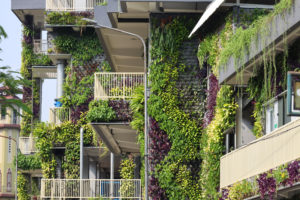There is an increasing interest in green space as an intervention to improve public health. Green spaces integrated into cities provide health benefits including the abatement of air pollution and the reducing urban heat island effects. Plants are good for our health with both indirect effects and physical benefits. Plants need to be kept close to where people are acting as physical barriers between high emitting air pollution sources, such as traffic lanes and industry, and ideally are comprised of native vegetation.
Green Spaces improve human health
Green spaces have positive health benefits and improve community wellness, “Urban green space, such as parks, playgrounds, and residential greenery, can promote mental and physical health and reduce morbidity and mortality in urban residents by providing psychological relaxation and stress alleviation, stimulating social cohesion, supporting physical activity, and reducing exposure to air pollutants, noise and excessive heat.” Urban green space improves human health generally.
Susan Prescott, a Professor of Pediatrics at the University of Western Australia, says that, “The evidence of the value of greenspace for health is overwhelming. From immune, psychological, physicality, microbiome, activity, social cohesion, and even reducing crime in neighborhoods. It is so important for child health and development. New studies indicate it has benefits for health behavior including healthier food choices.”
Green space exposure improves microbiome health. Exposure to urban green spaces can increase skin and nasal microbial diversity suggesting exposure to diverse outdoor environments may increase the microbial diversity for positive health outcomes. Green walls installed in office rooms in a two-week intervention increased skin Proteobacteria and Gammaproteobacteria with associated immunomodulatory effects compared with control subjects, suggesting the health benefits of green infrastructure. In the first trial with greening in daycare setting, urban environmental biodiversity had demonstrated effects on the commensal microbiome and immunoregulation in children.
Increasing green spaces generally improve community health outcomes, including mental health, “a variety of green spaces, rather than a standard configuration of a single type of green space and/or higher concentrations of a certain green space type or quality, may meet the needs of various types of green space users, especially in highly diverse and dynamic urban and peri-urban settings, and while facing the consequences of climate change.”
In one of the most famous papers on urban green space, the researchers used mobile electroencephalography (EEG) recorders to measure participants taking a 25 min walk through three different areas of Edinburgh. In the paper, they showed evidence of systematic differences in EEG recordings and “lower frustration, engagement and arousal, and higher meditation when moving into the green space zone; and higher engagement when moving out of it”. The study provides strong physical evidence for promoting urban green space for improving happiness.

Plant Selection
Green space removes many types of air pollutants and can be one tool in a toolbox for managing air quality. The filtration that plants provide varies by the types of vegetation, the size of the leaves, and the age of the plants. So, it’s good to select a range of plants. Combinations of species are more supportive than monocultures as plants filter pollutants differently and can be active at different times during the year.
David Rojas-Rueda an Assistant Professor in Epidemiology at Colorado State University advises to, “Choose a variety of plants, of different species and put them in places where they require less maintenance. Choose plants with larger leaves and less pollen. Select for native plants that are specific to the region that you’re in. Put them in close proximity to people. Where people move, live, and work is where you need green spaces. Everyone needs easy access to vegetation, not on a hill far away.”
Plants need to be specific to the region that you are putting them in. Try to avoid exotic plants. Local organizations such as universities and native plant societies can provide guidance on which native plants are appropriate for your specific location. Native plant societies such as these examples, from North America, South Africa, and Australia can help you select native plants for your urban design planning. Some ornamental plants look beautiful but have lots of pollen, so selecting native plants that have low pollen can help avoid plants that can add to respiratory irritants later.

Plant Placement
Plants in urban areas need to be integrated into the city, near people, as much as possible. For example, communities that are installing physical barriers between car lanes and either bike lanes or pedestrian pathways can substitute plant barriers for plastic or concrete barriers. In addition to filtering pollutants directly, plants also provide cover over asphalt that lowers air temperature and indirectly reduces air pollution.
Make substitutions by swapping higher polluting spaces for green spaces. You can swap cars, parking spaces, or traffic lanes for trees. Supposing you have a large flat parking lot in a city, the heat index from asphalt is high contributing to urban heat island effects and the cars increase particulate matter contributing to air pollution. If you swap every third or fourth parking space for a tree, then you cool the space and add air filtration.
Specific design characteristics for creating effective roadside vegetation barriers to reduce air pollution along transportation routes are that, “generally, a vegetation barrier along a high-volume highway should be tall, thick, and dense to achieve greater reductions in downwind pollutant concentrations.” Vegetation barriers will only be effective at reducing air pollution in urban areas with limited space for planting if there’s full coverage from the ground to top of the canopy.
Whenever feasible, native species should be considered for implementing the roadside barrier. Native species will usually be more robust and resistant to local climatic conditions. Yet, there are several barriers. Tree maintenance can be expensive and sometimes it can be hard to know where to put them.
Here are some general guidelines:
- Select native and local plants that do not need a lot of water or fertilizer. Not all cities need the same trees. Vegetation should be adapted to where you are on the planet which will reduce water, fertilizer, and maintenance costs.
- Create small parks in pockets wherever is available, such as transforming vacant lots and parking lots into green spaces.
- Incorporate green roofs and green walls wherever they’re available as a barrier between cars and transportation lanes. Substitute plastic or metal traffic barriers for plant barriers.
- Transportation rain trams have rocks in alleys, swap them for plants.
- Add plants to yards, facades, and windows. This can be supported at both a policy level and through individual contributions. Cities can support residents and industry landscaping who would like to participate in these efforts by providing urban green space plans with easy access to native plant guidance, free plants and incentives for landscaping transitions.

Tools for Improving Greenspace
Stakeholders should be using green space as a tool in their toolbox to improve air quality, tools such as GreenUR and iTree can help determine where and how much green space to include in your city planning. GreenUR is a tool that helps quantify the health benefits of green spaces to guide policy decisions. You can use the GreenUR tool to map out green spaces in your city as a planning tool for where to add more green spaces. Policy is used as a driver to help invest in cities for example deciding where to increase future urban tree canopy and by how much. GreenUR can collect data to help identify where to put plants. It can also be used to quantify the health impacts of the greenspaces you currently have.
iTree provides peer-reviewed tree benefits estimation science from the USDA Forest Service to all types of users with free tools and support. Developed by USDA Forest Service, iTree is designed to set priorities for more effective green space decision-making. There are substantial health benefits for communities in increasing green spaces in improving livability, health, and equity with the potential to improve biodiversity and climate resilience both now and in the future.